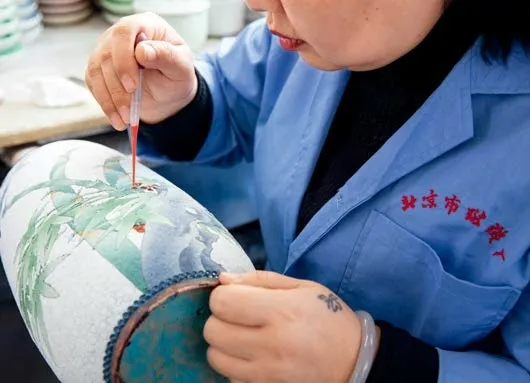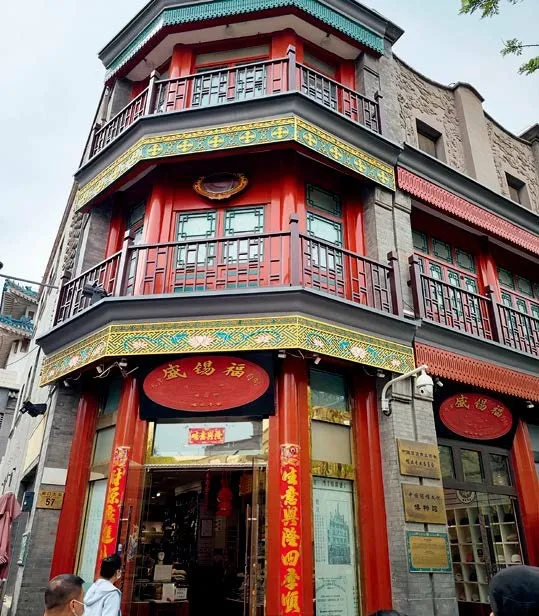The Heart of Beijing Flavor
2024-10-19byYangJianye
Various folk arts and crafts embedded in regional culture and customs are integral parts of the Central Axis of Beijing. In particular, the historical blocks along the Central Axis such as Tianqiao and Qianmen, as well as the areas around the Forbidden City and the Drum Tower, preserve many cultural heritage items inherited across generations.
Tianqiao was the most representative entertainment hub in Beijing from the late Qing Dynasty (1644-1911) to the founding of the People’s Republic of China in 1949. Many even liken Tianqiao acrobatic performances to old Beijing culture. At present, many old folk arts and customs have regained life in the renovated Tianqiao area, and visitors can enjoy Tianqiao acrobatic performances at cultural events organized by local communities.
Qianmen occupies a unique position in Beijing’s Central Axis. It concentrates diverse cultures and folk customs of old Beijing and is home to almost all time-honored brands in the ancient capital. In addition, many representative inheritors of intangible cultural heritage items live in the area. Their personal stories and understanding of life are closely associated with the history of Qianmen and the Central Axis.
If the Central Axis is the soul and backbone of Beijing, the colorful folk arts and crafts scattered along the line are the marrow of the city and the heart of Beijing flavor.

Longshuncheng Furniture
Longshuncheng is a century-old brand that specializes in traditional Chinese furniture. As a representative of Beijing-style royal furniture, its operations can be traced back to 1862.
It uses rare hardwood varieties such as Pterocarpus santalinus from India, Dalbergia cochinchinensis Pierre from Laos, and Pterocarpus pedatus Pierre from Myanmar as raw materials. The surface of the furniture it produces is processed with a waxing technique to retain the natural texture of wood. Longshuncheng also has an antique furniture repair center with the national first-class qualification for cultural relic restoration.

Chinese Cloisonné
A component of the royal culture of the Ming (1368-1644) and Qing dynasties and a representative of traditional handicrafts in Beijing, Chinese cloisonné has a history of more than 600 years. Using gold, silver, copper and other natural minerals as raw materials, it integrates drawing, carving, inlaying and other techniques. A national treasure unique to Beijing, Chinese cloisonné boasts elegant and gorgeous designs, with a distinctive ethnic style and profound cultural connotations. Chinese cloisonné objects are widely used as collectibles, souvenirs, and ornaments.

Dabei Photo Studio
Dabei Photo Studio, established in 1921, has a history of more than 100 years. In its early days, the studio earned fame for theatrical photography. One of the earliest photo studios in China, Dabei has become a time-honored photographic brand with great vitality and technical expertise. Today, it has one headquarters and seven branch stores.

Changchuntang
Changchuntang, founded in the mid-Qing Dynasty, is a time-honored pharmacy in Beijing. It integrated traditional Chinese medicine (TCM) with Taoist philosophy to form a unique TCM culture. The heat-clearing medicines it produces, Biwen San (Plaque-Dispelling Powder) and Wuji Dan (Ultimate Pill), were included in the first pharmacopoeia of the People’s Republic of China. At present, the pharmacy has business space of more than 200 square meters.

Longqingxiang
Founded in 1522, Longqingxiang is a centuriesold haute couture brand known in China for superb sewing techniques and comfortable designs. Back in the Ming and Qing dynasties, it received rewards from the royal court several times. A time-honored brand in Beijing, Longqingxiang integrates Chinese elements such as embroidery, blue-and-white porcelain, and seal cutting into customized clothes, producing apparel masterpieces that showcase the charm of traditional Chinese culture.

Shengxifu
Shengxifu is a time-honored hat brand in Beijing with a headquarters in Tianjin. Shengxifu hats are popular with customers both in China and beyond for their superb raw materials, exquisite craftsmanship, and excellent quality. The firm’s hat-making technique has been inscribed on the list of national intangible cultural heritage. In July 2012, Shengxifu’s Qianmen store opened the Chinese Hat Culture Museum, in which more than 300 pieces of cultural relics and historical photos related to China’s hat industry were put on display.

Paper Lanterns
Paper lanterns are a traditional Beijing handicraft. The making process consists of more than 20 steps including bamboo slipping, framework weaving, paper dyeing, pasting, and drawing. Beijing paper lanterns flourished in the Qing Dynasty. Back then, almost all families decorated their houses with lanterns during the Spring Festival and the Lantern Festival to convey aspirations for a better life.
